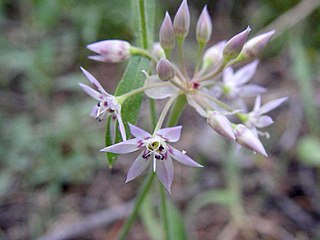
Allium canadense, the Canada onion, Canadian garlic, wild garlic, meadow garlic and wild onion is a perennial plant native to eastern North America from Texas to Florida to New Brunswick to Montana. The species is also cultivated in other regions as an ornamental and as a garden culinary herb. The plant is also reportedly naturalized in Cuba.

Allium validum is a species of flowering plant commonly called swamp onion, wild onion, Pacific onion, or Pacific mountain onion. It is native to the Cascade Range, the Sierra Nevada, the Rocky Mountains, and other high-elevation regions in California, Oregon, Washington, Nevada, Idaho and British Columbia. It is a perennial herb and grows in swampy meadows at medium and high elevations.

Allium cernuum, known as nodding onion or lady's leek, is a perennial plant in the genus Allium. It grows in open areas in North America.

Allium unifolium, the one-leaf onion or American garlic, is a North American species of wild onion. It is native to the coastal mountain ranges of California, Oregon, and Baja California. It grows on clay soils including serpentine, at elevations up to 1100 m.

Allium acuminatum, also known as the tapertip onion or Hooker's onion, is a species in the genus Allium native to North America.

Allium amplectens, the narrowleaf onion, is a species of flowering plant. It is an onion native to the west coast of the United States, in Oregon, Washington State and California, also British Columbia in Canada. It grows in woods and especially in clay and serpentine soils.

Allium campanulatum is a species of wild onion known by the common name dusky onion or Sierra onion. This is a flowering plant native to the western United States from southeastern Washington and northern Oregon to southern California, and western Nevada. The dusky onion grows in foothills and mountains, especially in dry areas, such as chaparral habitats.

Allium abramsii is a species of wild onion known by the common name Abrams' onion.
Allium dictuon is a species of wild onion known by the common name Blue Mountain onion. It is native to a small section of the Blue Mountains straddling the border between southeastern Washington and northeastern Oregon in the United States. It grows in Columbia, Garfield and Walla Walla Counties in Washington, plus Umatilla and Wallowa Counties in Oregon.

Allium aaseae, the Southern Idaho onion or Aase's onion, is a plant species endemic to southwestern Idaho. It has been reported from 6 counties: Elmore, Ada, Boise, Gem, Payette and Washington.

Allium brandegeei is a plant species native to the western United States. It has been reported from western Colorado, Utah, Idaho, eastern Oregon, Park County, Montana and Elko County, Nevada.

Allium geyeri or Geyer's onion is a North American species of onion widespread in the western United States and in western Canada. It is found in the Rocky Mountain States from New Mexico to Idaho, Great Basin, the Pacific Northwest, Texas, South Dakota, Arizona, Manitoba, British Columbia, Alberta and Saskatchewan.
Allium madidum, common name mountain swamp onion, is a plant species native to the west-central Idaho, southern Washington and eastern Oregon. It grows in wet meadows at elevations of 1100–2000 m.

Allium robinsonii, the Columbia River onion or Robinson's onion, is a rare plant species native to the US States of Washington and Oregon, although some studies suggest that the Oregon populations may now be extinct. The species has been reported from five counties in Washington and five in Oregon. It is found in sand and gravel deposits along the lower Columbia River and some of its tributaries, usually at elevations less than 200 m. The species is also cultivated as an ornamental in other regions, including in Europe.

Allium scilloides, called the fragile onion, is a plant species endemic to the US State of Washington. It has been reported from only 4 counties, all on the eastern side of the Cascade Range: Klickitat, Kittitas, Yakima and Grant. It grows on barren, gravelly or rocky slopes at elevations of 300–1300 m. The species is sometimes cultivated in other regions as an ornamental.

Allium tolmiei is a plant species native to Idaho, eastern and central Oregon, southeastern Washington, northwestern Nevada and northeastern California. It occurs on mountains and scrublands at elevations of 1,300–9,200 feet (400–2,800 m). It was discovered by and named for Dr. William Fraser Tolmie.

Allium brevistylum is a plant species native to the western United States. It grows in meadows and along stream banks high in the mountains of Colorado, Utah, Wyoming, Montana and Idaho, at elevations of 2200–3400 m.

Allium cuthbertii, common name striped garlic, is a plant species native to the southeastern United States. It occurs at elevations less than 300 m in Alabama, Georgia, North and South Carolina, and northeastern Florida. It is a perennial herb.

Allium douglasii, the Douglas' onion, is a perennial herbaceous flowering plant in the Amaryllidaceae family. It is native to northeastern Oregon, eastern Washington, and northern Idaho.

Allium crenulatum, common name Olympic onion, is a plant species native to Oregon, Washington, and British Columbia. It grows in the Cascades, the Coast Ranges, the Olympic Mountains, the Wenatchee Mountains, and the mountains on Vancouver Island. There is one report from Alabama, but this needs verification. The species grows on talus slopes and in alpine tundra at elevations of 600–2500 m.



















